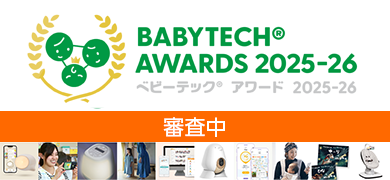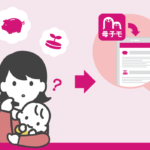Parents' desire to use child safety seats for their children's safety and the current rush to graduate from child safety seats. A safe choice that matches the growth of the child, for a future that fosters peace of mind.
- The following is content from the press release -
CTP JAPAN, a trading company of the German parenting brand "CYBEX" (headquartered in Shibuya-ku, Tokyo), conducted a survey of 1,000 parents with children between the ages of 3 and 12 on the use of child safety seats under the supervision of pediatrician Dr. Tatsuhiro Yamanaka (advisor to Safe Kids Japan, a non-profit organization). (headquartered in Shibuya-ku, Tokyo) conducted a survey of 1,000 parents with children between the ages of 3 and 12 on the actual use of child safety seats under the supervision of pediatrician Dr. Tatsuhiro Yamanaka (advisor to NPO Safe Kids Japan).

introduction
In September 2024, JAF (Japan Automobile Federation) announced that the guideline for the use of child safety seats will be changed from "less than 140 cm in height" to "less than 150 cm in height "*. This is in response to the fact that it has become clear that the current law, which is based on the age of "up to 6 years old," does not adequately protect the safety of children. Parents of children are now being asked to review the criteria for judging the use of child safety seats.
*Seat belts in cars are designed for passengers 150 cm tall or taller.
In Japan, the legal obligation to use a child safety seat is still limited to "under 6 years of age," and the majority of families "base their decision to graduate to a child safety seat on this age. As a result, there are many cases where child seats are removed early without a proper understanding of the child's physique and safety. Unfortunately, accidents resulting in loss of life have also occurred as a result of not using a child safety seat or junior seat.
Against this background, the purpose of this survey was to clarify the extent to which parents are aware of the new recommended guideline that "a child safety seat should be 150 cm in length if it is to protect the safety of the child," as well as to quantitatively understand potential reasons and motives that parents have for removing child safety seats. The purpose of the survey was to gain a quantitative understanding of parents' potential reasons and motivations for removing child safety seats, and to obtain knowledge that can be used as a reference for future discussions on raising awareness and improving the child safety seat system.
Survey Summary
- [20% of child safety seat use after the child is over 6 years old.
About 60% of the respondents answered that they "always used" a child safety seat until they were under 6 years old, while only about 20% answered that they "always used" a child safety seat after the age of 6. Many people graduate from using a child safety seat at the age of "6 years old" as a standard. - [The standard "child seat use is recommended for children under 150 cm in height" is not widespread.
About 40% of respondents were not aware of the JAF-recommended standard of "using a child safety seat up to 150 cm in height," and about 20% said they knew about it but had graduated (or were planning to graduate) their child safety seat, indicating that awareness of height-based child safety seat use is not yet widely spread. - Many parents are leaving car seats for reasons other than "safety.
The majority of reasons for graduating from child safety seats were factors other than "safety," such as "the child didn't like it" and "it no longer fits the child's physique. - The information parents want to know the most is "accident cases.
When asked what kind of information or experience would make them willing to use a child safety seat until their child reaches 150 cm, more than 40% of all respondents answered "accident cases. - More than 80% of parents "want to use a child safety seat if it is for safety reasons.
More than 80% of the respondents answered that they think it is better to continue to use a child safety seat for children under 150 cm regardless of age if it is for their safety.
Survey Summary
Number of persons surveyed: 1,000
[Survey period] June 19, 2025 - July 1, 2025
Surveyed] Car-owning parents with children aged 3~12.
Research entity] Freeasy
[Survey period] June 2025
Questionnaire title: Survey on attitudes toward children
results (of a study)
Q1. how often do you use a child seat or junior seat*?
*In subsequent questions, the term "child seat" will be used.
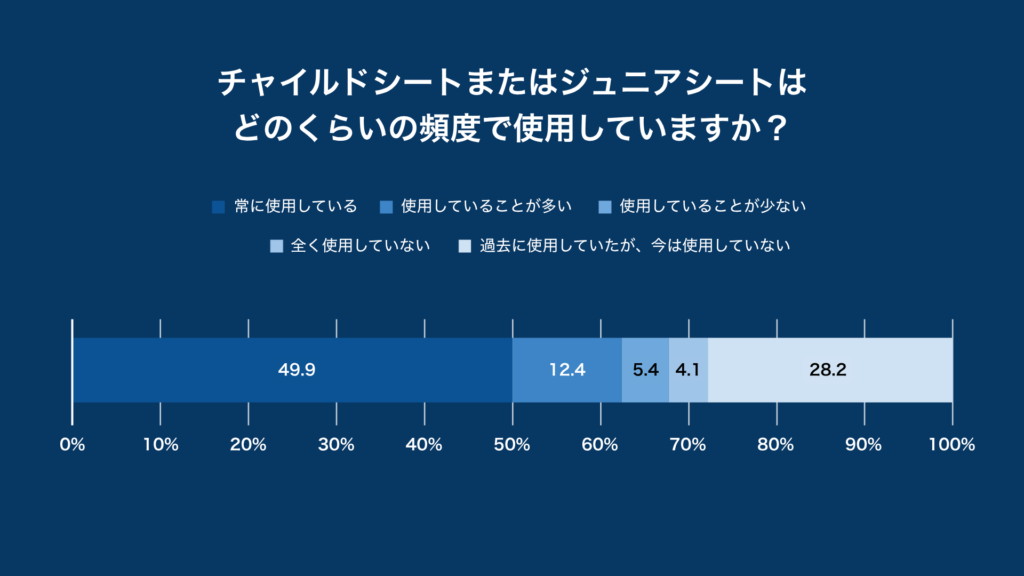
- About half of all respondents (49.91 TP6T) answered that they "always use it."
- 28.21 TP6T of all respondents answered, "I used to use it in the past but not anymore."
- Percentage of people who use child safety seats permanently in general
Q2. When you were using a child safety seat, how often did you use it until your child was how old?
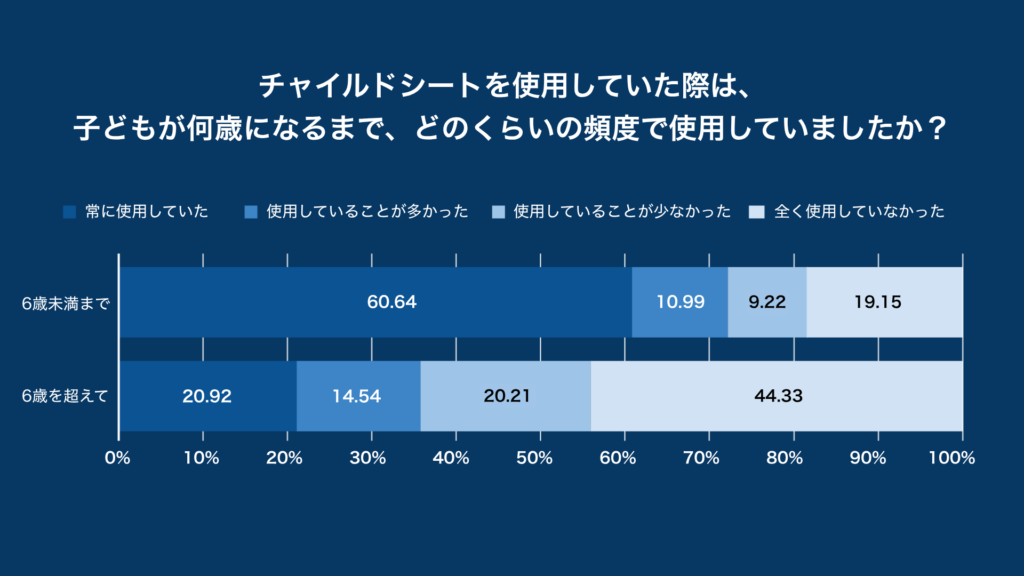
- 19.15% of the total respondents answered that they "did not use it at all" even in the "up to 6 years old" age group, which is obligated by the legal system to use it.
- In the "over 6 years old" category, where use is not required by law, the rate of use declined sharply, with only 20.921 TP6T of the total respondents saying they "always used" the product, while the number of respondents saying they "never used" the product rose sharply to 44.331 TP6T of the total respondents.
- The trend that the existence of a legal obligation "up to the age of 6" is the criterion for judging the use of child safety seats is clearly evident.
Q3. do you know that you are obliged to use a child safety seat?
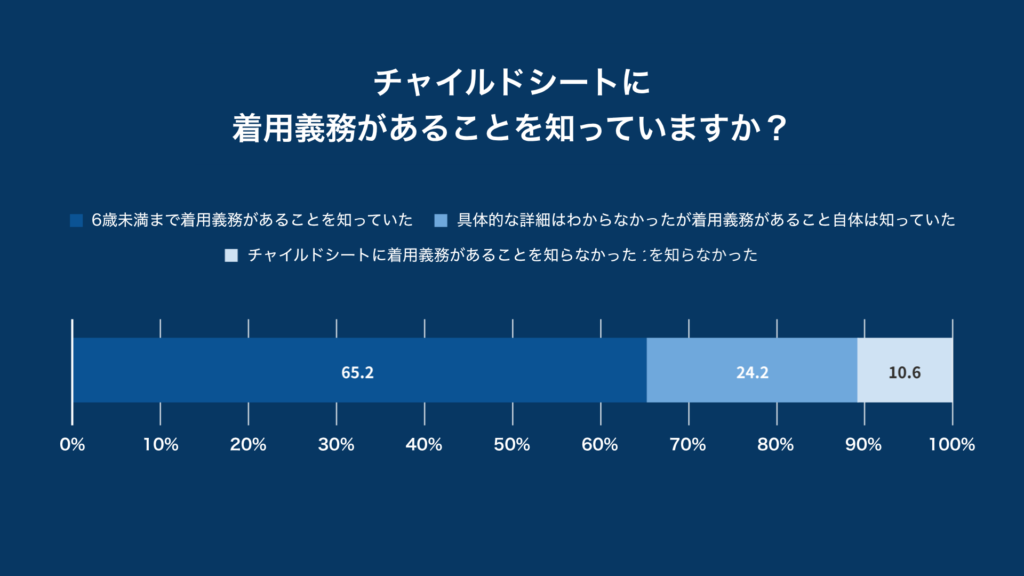
- Only 65.21 TP6T of all respondents correctly understood that "the obligation extends to under 6 years of age."
- 10.61 TP6T of the total respondents were unaware that they were obligated to use the product.
- It also highlighted the current situation where legal standards have not fully penetrated the market.
Q4: Are you aware that JAF has raised the guideline for the use of child safety seats from less than 140 cm to less than 150 cm in height?
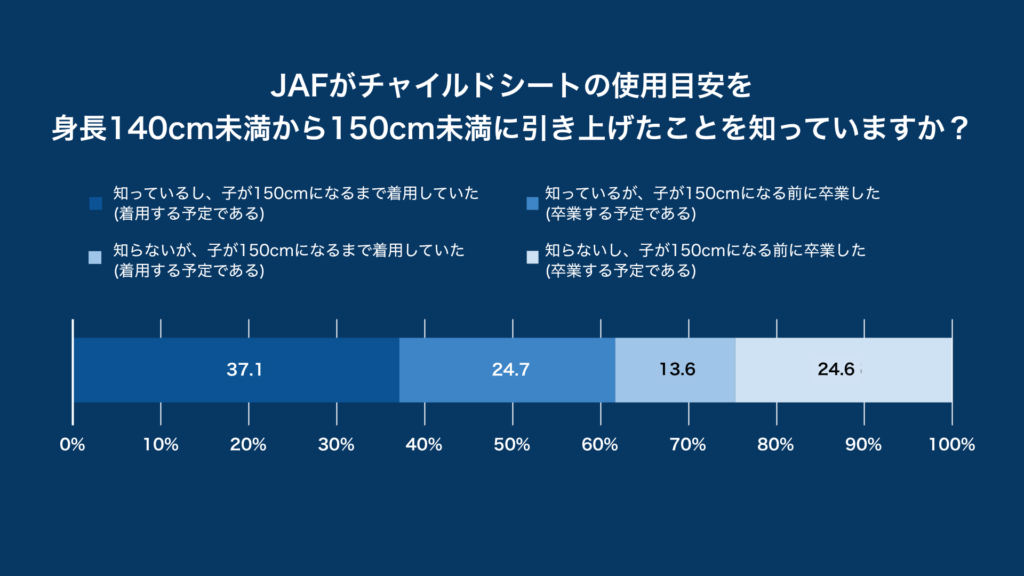
- 38.21 TP6T (13.61 TP6T+24.61 TP6T) of the total respondents were unaware of the standard that "less than 150 cm is recommended to use a child safety seat.
- The percentage of respondents who answered "knew about it but let them graduate (or plan to let them graduate)" was 24.7%, indicating that there is a certain segment of the population that has knowledge but has not implemented it.
- It was clear that the less-than-150-cm guideline is not yet fully penetrated.
Q5. If you were to graduate to a child safety seat in the future, for what reasons would you consider doing so? Please rank up to 5 that you feel are most likely to apply. (*This question was asked to those who are currently using a child safety seat.)
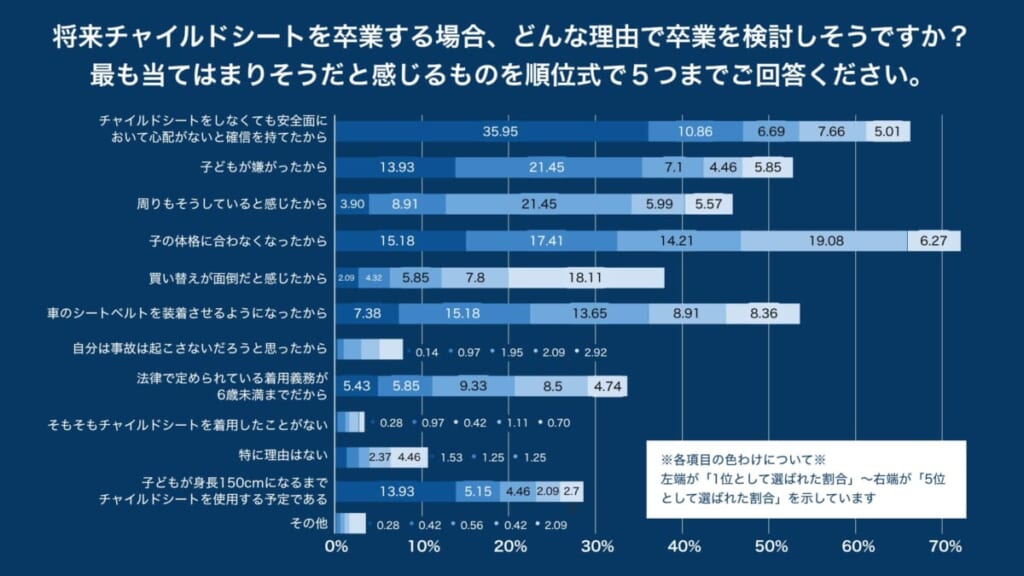
- Only 13.931 TP6T of all respondents answered that they "plan to use a child safety seat until the child reaches 150 cm in height.
- The other reason was that "I was confident that I would not have to worry about safety without a child safety seat" was ranked first by 35.931 TP6T of the total respondents.
- More than half of all respondents are considering graduating their children for reasons different from safety, such as "because the child didn't want to" or "because the child no longer fits the child's physique.
Q-6 For what reasons did you consider graduating from a child safety seat? Please answer up to 5 in rank order that you feel are most applicable. (*This question was asked to those who had used a child safety seat in the past.)
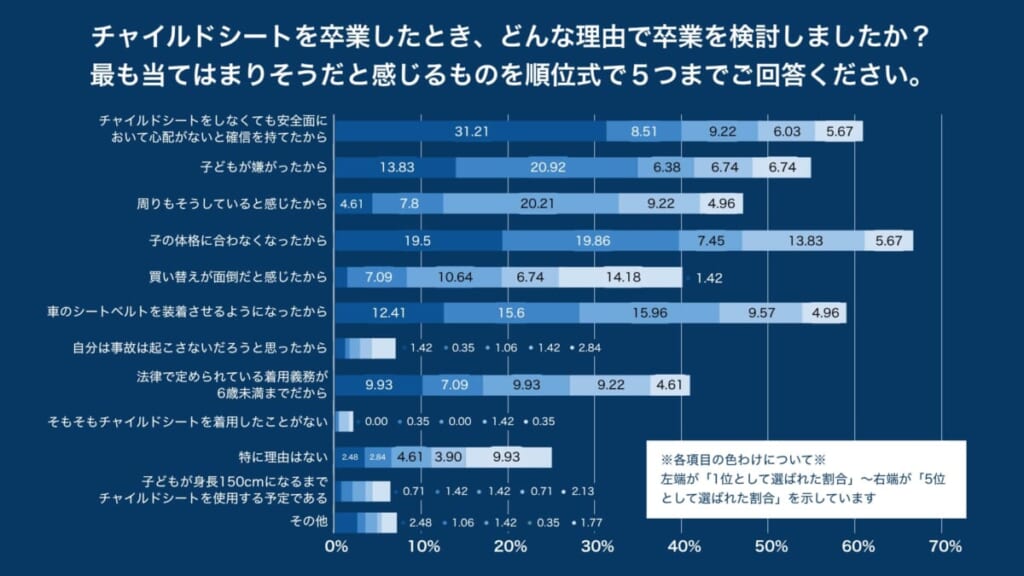
- Of those who graduated from child safety seats, 31.21% of the total respondents chose "because I am confident that I don't have to worry about safety without a child safety seat" as their No. 1 answer.
- The highest response rate (66.311 TP6T) was obtained for "no longer fits the child's physique"
- More than half of all respondents graduated their children for reasons different from safety, such as "because the child didn't want to" or "because the child no longer fits the child's physique.
Q7. The obligation to use a child safety seat is up to under 6 years old, but there is data that "the fatality and serious illness rate increases more than twice as much when a child safety seat is not used even at the age of 6 or older". Knowing this, which of the following applies to your awareness of child safety seat use and graduation? (*This question is for those who are currently using a child safety seat.)
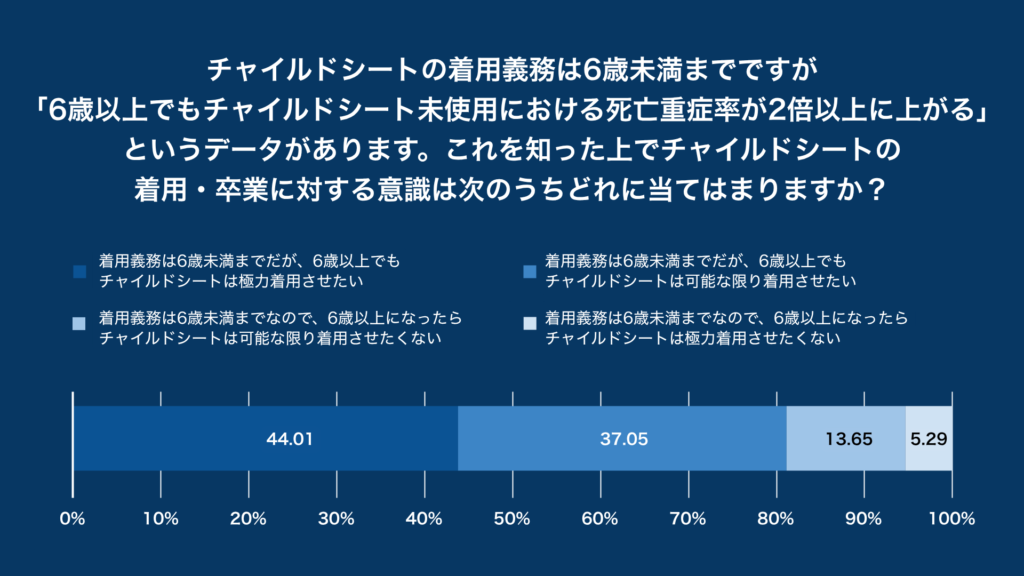
- 81.06% (44.01%+37.05%) responded that they would "allow their children to use a child safety seat even if they are 6 years old or older if it is for their safety.
- It was found that "accurate information about risks" has a stronger influence on awareness and behavior than laws.
Q8. The obligation to use a child safety seat is up to under 6 years old, but there is data that "the fatality and serious illness rate increases more than twice as much when a child safety seat is not used even at the age of 6 or older". Knowing this, which of the following applies to your awareness of child safety seat use and graduation? (*This question is for those who have used a child safety seat in the past.)
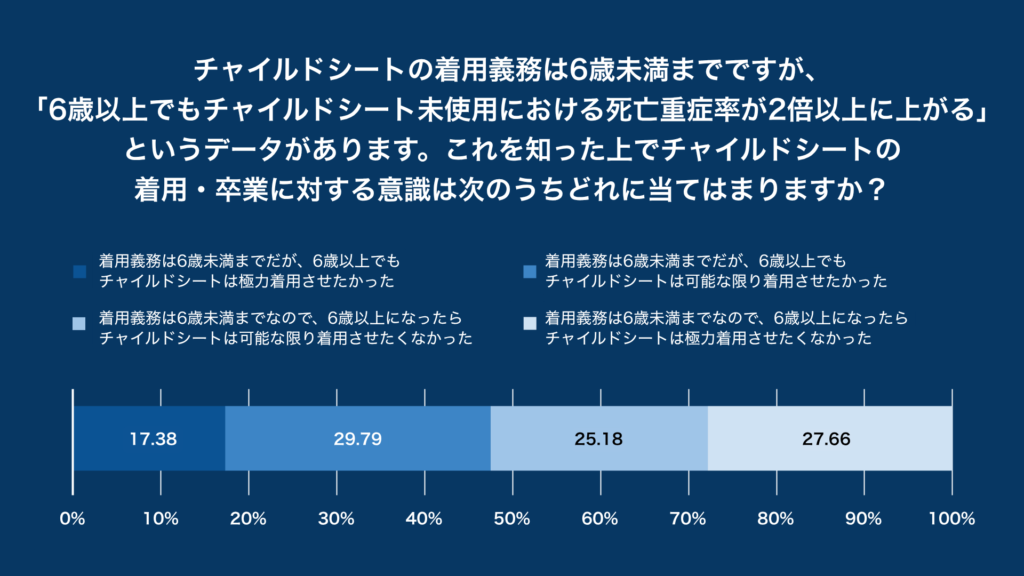
- Only 47.171 TP6T responded that they "wanted them to use it."
- Positive responses were significantly lower than those of the currently using group, suggesting that "whether or not I knew when I was using the child safety seat" had a strong influence on awareness.
Q9. What kind of information or experience would make you willing to use a child safety seat until your child reaches 150 cm? Please answer up to 5 in rank order. (*This question is for those who are currently using a child safety seat.)
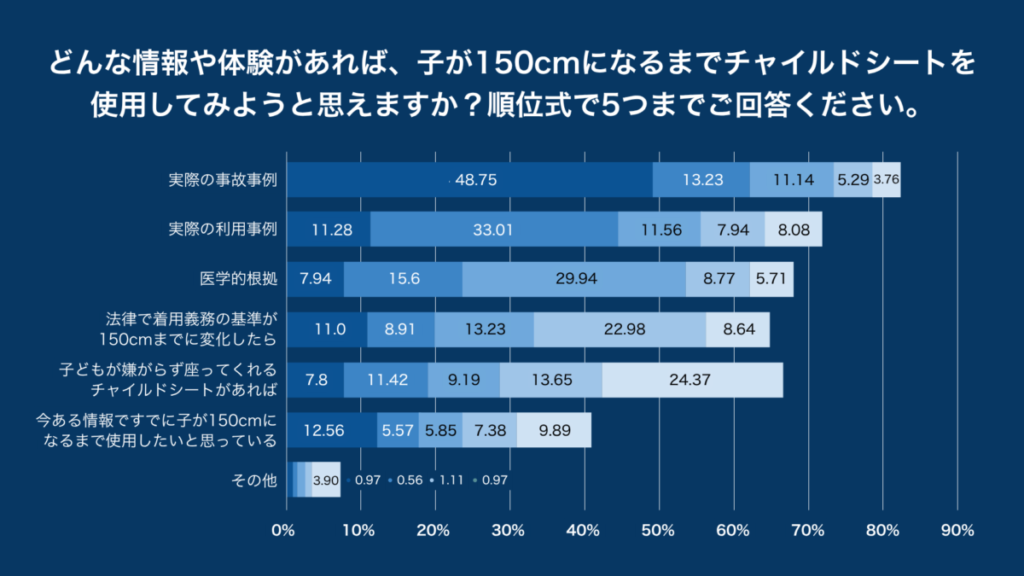
- About half of all respondents (48.751 TP6T) chose "actual accident cases" as the number one response, which was by far the highest response rate than the other responses.
- Knowledge of specific risks is expected to promote child safety seat use
Q.10 What information or experience would have made you decide to use a child safety seat until your child was 150 cm? Please answer up to 5 in rank order. (*This question is for those who have used a child safety seat in the past.)
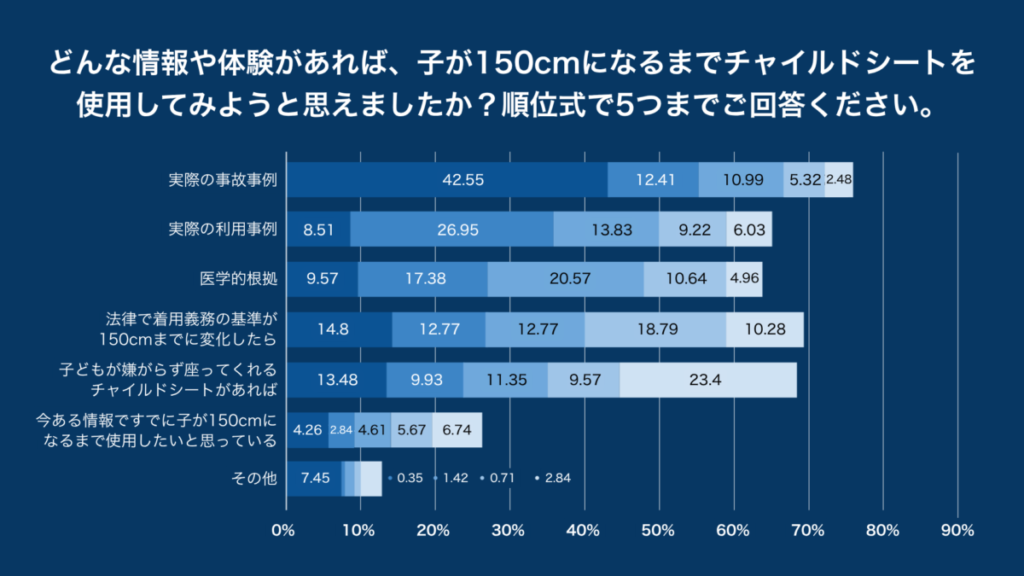
- 42.551 TP6T responded "actual accident cases" as number 1, which was by far the highest response rate than the other responses.
- 13.48% answered "If there is a child seat that the child does not mind sitting in" as No. 1, about twice as many as the group that currently uses a child seat.
Q.11 Do you think it is better to continue to use a child safety seat for children under 150 cm regardless of age if it is effective in protecting their safety?
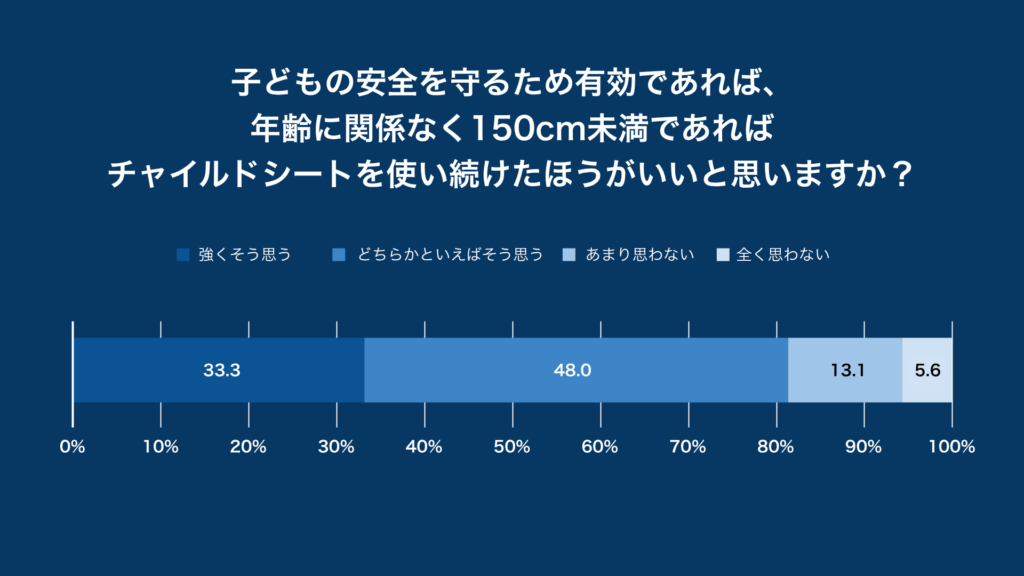
- 81.31 TP6T (33.31 TP6T+48.01 TP6T) of the respondents responded "strongly agree" or "somewhat agree," indicating a high degree of sympathy for the use of height criteria
- Parents' willingness to make decisions based on "safety and effectiveness" rather than age is evident.
Through this survey, it became clear that only about 60% of all respondents were aware of the standard that the guideline for the use of a child safety seat is "less than 150 cm in height.
On the other hand, more than 80% parents thought that "a child seat should be used even if the child is 6 years old or older if it is for the child's safety," indicating a high awareness of safety orientation. Among them, "Even if the child is 7 years old or older, I don't think it is safe to use a regular seat belt," "I think safety comes first," and "Now that seat belts can also be worn, I strongly felt that parents should not put their children in danger because of their own selfish belief that the child might be cramped. I felt again that we cannot take back what we have lost after something happens.
However, only about 30% of all respondents answered that the reason they graduated their child from a child safety seat was because they were "confident that there were no safety concerns. Although many families want to emphasize the safety of their children, the results highlight the fact that the reasons for graduating from child safety seats are not "safety" but "legal system" and "parental self-judgment".
consideration
This survey shows the reality that the current child seat graduation decision depends on "systems" and "parents' own sense" and is not based on essential safety standards. In the future, it will be even more necessary to spread the use of child safety seats based on "height (physique)" rather than "age".
If the dangers of not using a child safety seat and the safety that comes with its use are widely spread throughout society, the use rate of child safety seats will further increase, and the opportunities to protect children's lives will surely increase. In order to achieve this, it is essential not only to change the awareness of parents, but also to promote the use standards and the correct selection of products among all parties concerned, including the transportation industry and the childcare and childcare industry.
Dr. Tatsuhiro Yamanaka, a pediatrician and advisor to Safe Kids Japan, a non-profit organization that has long been involved in preventing accidents involving children, stated the following
Until now, the legally mandated child safety seat use rate for children under six years of age has been reported annually, but data on the use rate for children over six years of age was not available. The survey revealed that the decision to graduate from child safety seats is often based on the reason that the child has turned 6 years old or that the seat no longer fits the child's physique. Seat belts and child restraints, which secure the body to the car, are essential safety braces, but there are differences in their use: when a child under 150 cm is wearing a seat belt and the car crashes, the seat belt cuts strongly into the abdomen, and there have actually been cases of death. The transition to the use of seat belts should be made "when the child reaches 150 cm in height. We ask that you keep height in mind when making decisions and make choices that will protect your child's precious life.
We hope that this survey will lead to a step-by-step expansion of "standards for the use of child safety seats according to height (body size) as a way to raise awareness for child safety," both at home and in society.
Note: The "Child Safety Seat Usage Survey 2024," jointly conducted by the National Police Agency and the Japan Automobile Federation (JAF), uses direct interviews as its primary survey method. The results of this survey, which is based on a questionnaire, show similar data trends and are judged to be highly credible as data. (e.g., child safety seat usage rate for children under 6 years old 78% (JAF), 71% (this survey))
About CYBEX
WE ARE HERE TO DELIVER THE BEST PRODUCTS AND CONCEPTS FOR ALL FAMILIES TODAY AND TOMORROW.
CYBEX is a German parenting (baby products) brand that is highly regarded worldwide for its safety, design, and functionality. The product development (CYBEX D.S.F. Innovation Principle) has led to numerous high public accolades for safety and numerous awards for design. In 2014, CYBEX merged with Goodbaby International to create CYBEX D.S.F., an innovative lifestyle fashion brand that goes beyond the boundaries of baby products. In 2014, CYBEX merged with Goodbaby International and has grown to become the world's largest parenting brand, with Martin Pos, founder of CYBEX and father of two, leading the group as CEO. The company brings the best concepts and products to "families now and in the future.
About CTP JAPAN Corporation
CTP JAPAN K.K. (Columbus Trading-Partners Japan, Limited) is a specialized trading company established to ensure the delivery of products optimized for Japanese parents and is the "authorized sole import agent" for CYBEX products. CYBEX GmbH owns 1001 TP6T of the shares.
Cybex (brand) official websitehttps://cybex-online.com/ja-jp

